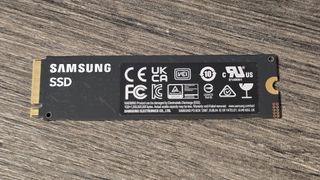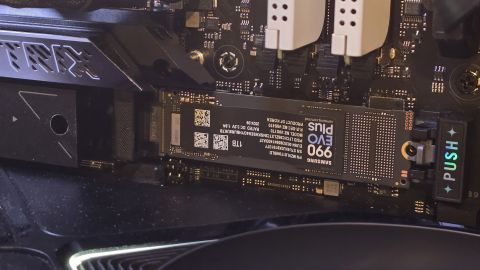Our Verdict
Samsung's 990 EVO Plus is a solid update on the original 990 EVO. It's far more efficient and packs greater sequential punch, but odd pricing and a lack of random 4K grunt hurt it in a highly competitive market.
For
- Strong sequential performance
- Impressively cool under load
- PCIe 5.0 x2 kinda useful
Against
- Random 4Ks fall short
- Pricing is not tight enough
PC Gamer's got your back
Few names in the PC gaming industry command quite as much respect as Samsung does with its SSDs. It's synonymous with that manufacturing avenue. Or at least it was. It's wild really; the company was absolutely dominant with PCIe 3.0 and early PCIe 4.0 SSDs. The 970 and 980 series were incredible and still remain popular today if PC Part Picker's stats are anything to be believed. It wasn't without merit either; Samsung's drives have typically always been high performers, suitably durable, and backed up by a solid warranty, with decent customer support (at least for the few times I've had to make contact with them).
Still, it's been over 17 months since the advent of PCIe 5.0 and the subsequent slew of Phison E27-powered performance SSDs, and since then, at least from Samsung, we've heard absolutely diddly squat on that front. Certainly, when it comes to dedicated drives.
Weirdly, Samsung's 990 EVO series, and now its 990 EVO Plus line (which I have on test here today), do bizarrely support the connection standard, but in a rather odd use-case, although more on that in a little bit.
So, top-line specs, what are we looking at here? Well, the 990 EVO Plus is available in three separate variants, ranging from 1 to 4 TB. Sequentials look to max out the PCIe 4.0 standard, with my 1 TB review sample topping out at 7,150 MB/s on the read and 6,300 MB/s on the write, and it's utilizing the M.2 2280 form factor, although the overall design suggests Sammy's been smart here and is optimizing it for use in OEM capacities as well.

Capacity: 1 TB
Interface: PCIe 4.0 x4 / PCIe 5.0 x2
Memory controller: Samsung Piccolo Controller
Flash memory: Samsung 236-Layer TLC V-NAND
Rated performance: 7,150 MB/s sustained read, 6,300 MB/s sustained write
Endurance: 600 TBW
Warranty: Five years
Price: $90 | £106 | AU$195
For the core hardware, the 990 EVO Plus, pairs Samsung's latest 236-layer TLC V-NAND with its proprietary in-house "Piccolo" controller (the same one found on the original 990 EVO). There's no DRAM cache here (mostly unnecessary due to the inclusion of TLC over QLC anyway), and you get a healthy 5-year warranty coupled with a fairly standard 600 TBW endurance rating as well (at least for the 1 TB variant).
It's that NAND flash upgrade that's the real talking point, however, as the previous Gen 990 EVO (which landed only nine months ago) had the far slower and much less efficient 133-layer TLC instead, significantly limiting its overall performance. As for price, the 990 EVO Plus is positioned at around $90 USD for the 1 TB variant, sliding right under that $100 1 TB mark quite comfortably.
So, performance. This is where things get interesting (relatively). Sequential performance is close to being on par with what Samsung advertised; during my test runs, seq read and write landed just under what was listed, with 7,071 MB/s on the read and 5,944 MB/s on the write. That's not far off of the marketing numbers, about 3-4 percent overall. In 3D Mark's Storage Bench, it scored a respectable 2,918 on the overall index, along with 498.17 MB/s on bandwidth and 61 ns on access time. That puts it slightly ahead of WD's latest Blue SN5000 4 TB that I tested earlier this month.
- CPU: AMD Ryzen 9 9900X
- RAM: 64GB (2x32GB) Team Group T-Create Expert DDR5 @ 6000 C34
- GPU: Nvidia GeForce RTX 4080 Super
- Motherboard: ASUS ROG Strix X870E-E Gaming WiFi
- SSD 1: 2TB Crucial T705 M.2 - PCIe 5.0
- SSD 2: 2TB Kingston Fury Renegade M.2 - PCIe 4.0
- CPU cooler: NZXT Kraken Elite 360 RGB
- PSU: 1200W NZXT C1200 (2024) 80+ Gold
- Chassis: NZXT H5 Flow RGB (2024)
Interestingly though, random 4K performance effectively fell off a proverbial cliff. Over three separate runs, the Samsung 990 EVO Plus landed only 68 MB/s on the read and 232 MB/s on the write. That's seriously slow, and a drop of around 22% on the read alone compared to similar drives. Less than ideal, particularly given this is meant to be a much faster-performing drive than the initial 990 EVO was. PCIe 4.0 drives like the WD Black SN770M (itself a 2230 small form factor SSD designed for handhelds) outperformed it rather aggressively in that arena. That then of course translated straight across into our Final Fantasy XIV load time testing too, with the 990 EVO Plus scoring a relatively sluggish 8.044 seconds overall average time remarkably.




✅ You want a decent drive with solid software: It's an ok all-round drive with good temps, and Samsung's Magician software is still kickass.
❌ You're looking for the best bang for the buck: There are still better drives out there for less that cover all the bases, and that's a problem.
As for temps, perhaps unsurprisingly for a single-sided 1 TB M.2 2280 SSD with brand spanking new, power-efficient NAND, the Samsung 990 EVO Plus did remarkably well. It managed a svelte 59.0 C at its peak. That's cool enough to comfortably sling it into any device you can think of without worry.
The question is, is this all too little, too late? From a sequential perspective, that 233-layer TLC is doing a lot of heavy lifting as far as the score is concerned. Random 4K, which is far more synonymous with game load times, is just a little dire in comparison to competing SSDs. Then there's the curious case of its PCIe 5.0 pedigree. At a guess, I can only assume that the x2 connectivity capacity Samsung's included (given it's exactly the same total bandwidth as PCIe 4.0 x4) is an effort to make it more versatile for more products and odd use cases. Ideal for devices that lack backwards compatibility perhaps, but it feels like a tease, one that's 17 months too late.
And then there's the price. Yes, the Samsung 990 Evo Plus is under $90 for that 1 TB capacity, but right now the market is flooded with far superior drives that outperform it for even less than that. Crucial's T500 is one of my most recommended SSDs to date. It has random 4K performance that competes with PCIe 5.0 SSDs, but at a fraction of the cost. Then there's WD with its Black SN850X drive, or Lexar with the ever-infamous NM790. Or Silicon Power with the 1 TB XS70. So many options. And that's the thing—there's just not a good enough reason to really justify this drive for a personal purchase. Is it good? Yes. But it's not great, and right now, you need to be great to get onto that best SSD ladder.
Samsung's 990 EVO Plus is a solid update on the original 990 EVO. It's far more efficient and packs greater sequential punch, but odd pricing and a lack of random 4K grunt hurt it in a highly competitive market.
After graduating from the University of Derby in 2014, Zak joined the PC Format and Maximum PC team as its resident staff writer. Specializing in PC building, and all forms of hardware and componentry, he soon worked his way up to editor-in-chief, leading the publication through the covid dark times. Since then, he’s dabbled in PR, working for Corsair for a while as its UK PR specialist, before returning to the fold as a tech journalist once again.
He now operates as a freelance tech editor, writing for all manner of publications, including PC Gamer, Maximum PC, Techradar, Gamesradar, PCGamesN, and Trusted Reviews as well. If there’s something happening in the tech industry it’s highly likely Zak has a strong opinion on it.

Overwatch: Classic brings the 2016 game back as a limited-time event and promises to 'capture the charm' of its original heroes and maps

Support for Windows Mail, Calendar and People apps will finish at the end of this year as new Outlook elbows its way onto the center stage

Material scientists create a new compound that has a thermal resistance up to 72% lower than some of the best liquid metals
